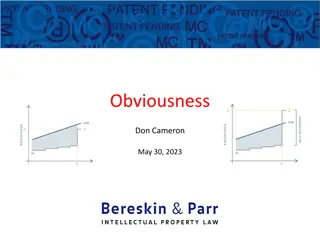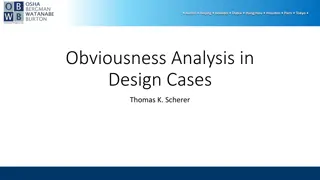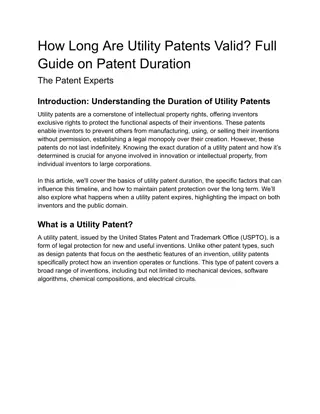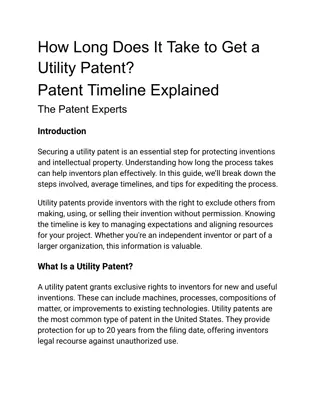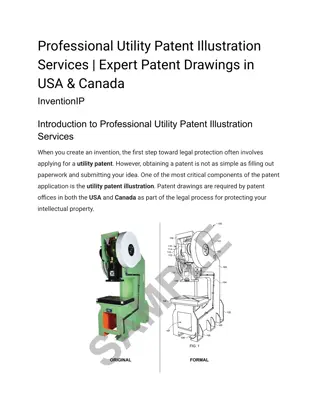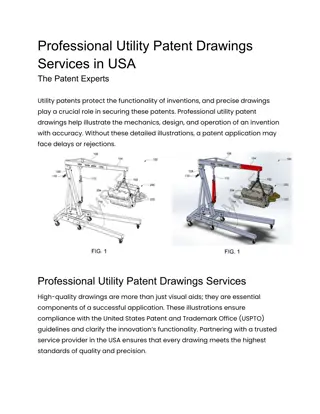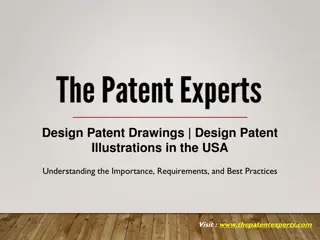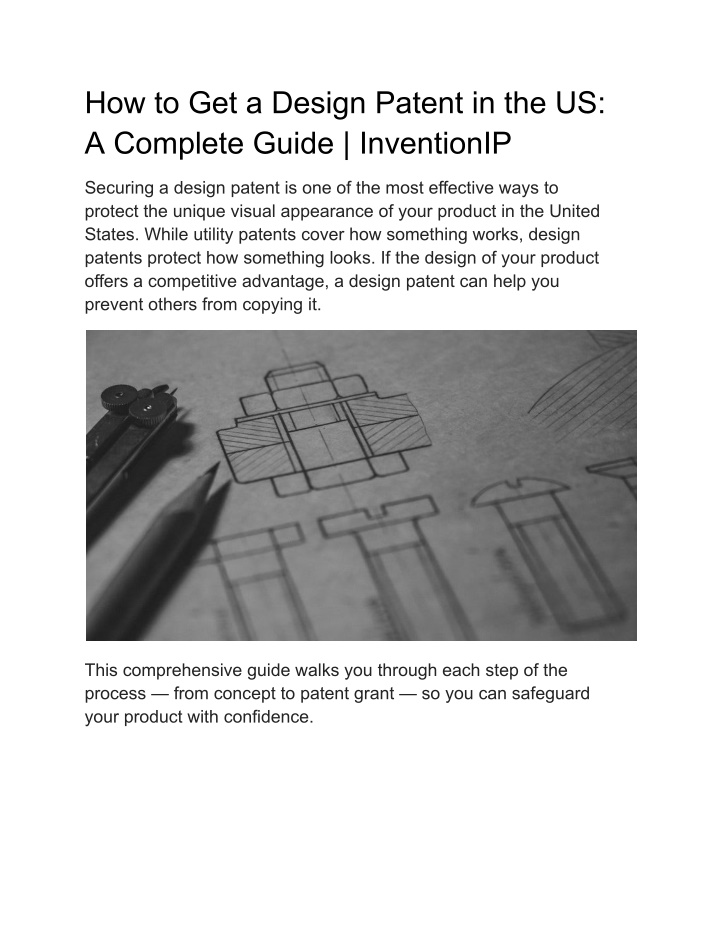
How to Get a Design Patent in the US | Step-by-Step Guide (2025)
Learn how to get a design patent in the US with this complete, step-by-step guide. Discover how to protect the unique appearance of your product, from preparing professional drawings and filing with the USPTO to handling office actions and enforcing
Uploaded on | 3 Views
Download Presentation

Please find below an Image/Link to download the presentation.
The content on the website is provided AS IS for your information and personal use only. It may not be sold, licensed, or shared on other websites without obtaining consent from the author. If you encounter any issues during the download, it is possible that the publisher has removed the file from their server.
You are allowed to download the files provided on this website for personal or commercial use, subject to the condition that they are used lawfully. All files are the property of their respective owners.
The content on the website is provided AS IS for your information and personal use only. It may not be sold, licensed, or shared on other websites without obtaining consent from the author.
E N D
Presentation Transcript
How to Get a Design Patent in the US: A Complete Guide | InventionIP Securing a design patent is one of the most effective ways to protect the unique visual appearance of your product in the United States. While utility patents cover how something works, design patents protect how something looks. If the design of your product offers a competitive advantage, a design patent can help you prevent others from copying it. This comprehensive guide walks you through each step of the process from concept to patent grant so you can safeguard your product with confidence.
What Is a Design Patent? A design patent grants legal protection to the ornamental design of a functional item. This includes the shape, configuration, surface decoration, or a combination of these elements. It does not cover the product s function only its appearance. Example: Think of the iconic shape of the Coca-Cola bottle or the sleek curves of an Apple iPhone. These designs are patented not because of how they work, but because of how they look. Benefits of a Design Patent Design patents offer several important advantages: Exclusive Rights: You have sole ownership of the visual design for 15 years. Deterrence: Competitors are less likely to copy a patented design. Increased Product Value: A patent enhances the market value of your product. Legal Remedy: You can sue for damages in case of infringement. A design patent is also faster and cheaper to obtain than a utility patent, making it an ideal starting point for inventors and businesses focused on aesthetics.
Step 1: Determine Eligibility Before filing, ensure your design meets the three core criteria: 1. Novelty: The design must be new. 2. Non-Obviousness: It must not be an obvious change to existing designs. 3. Ornamentality: The design must be purely decorative, not functional. Search the USPTO Design Patent Database to confirm your design hasn t already been patented. You can also use Google Patents for broader research. Step 2: Create Professional Patent Drawings Drawings are the most critical part of a design patent application. The USPTO requires multiple views front, back, top, bottom, left, right, and perspective. Why they matter: The drawings define the scope of your protection. Any error or lack of clarity can lead to a rejection. Tip: Hire professionals who specialize in design patent illustrations. This will ensure your drawings meet all USPTO standards. Get expert drawings here: inventionip.com/design-patent-drawings Step 3: Prepare the Application A design patent application must include:
Preamble: Includes the title, applicant, and a brief statement. Description of Figures: Each drawing should be described clearly. A Single Claim: Design patents have only one claim describing the visual elements. Drawings: As described above. Executed Oath or Declaration: Verifies the inventorship. Keep the language simple and descriptive. Avoid using technical jargon. You re describing visuals, not functionality. Step 4: File With the USPTO Submit your application using the USPTO s Patent Center. You ll need to: Create a USPTO account Upload your documents Pay the filing fee Filing fees: Micro entity: ~$50 Small entity: ~$100 Large entity: ~$200 Once filed, you ll receive an acknowledgment and an application number. Step 5: USPTO Examination Process After submission, a patent examiner will review your application. They ll ensure the design is new and meets all legal requirements.
You may receive an Office Action, which outlines issues or objections. Respond promptly and clearly. If all issues are resolved, your design patent will be granted. Timeframe: Typically, design patents are granted within 12 18 months. Step 6: Maintain and Enforce Your Patent Unlike utility patents, design patents do not require maintenance fees. However, enforcement is your responsibility. What you can do: Monitor the market for infringers Send cease-and-desist letters if needed File lawsuits if someone copies your design Real-World Examples and Case Studies Apple Inc. vs. Samsung Electronics In one of the most famous design patent lawsuits, Apple sued Samsung for infringing on the design of its iPhone. Apple held a design patent for the rectangular shape with rounded corners and grid of colorful icons. Outcome: Apple won over $500 million in damages. This case underscored the power of design patents in protecting product appearance. Fidget Spinner Craze
During the fidget spinner trend, inventors who patented unique designs gained a huge advantage. Others who didn t protect their designs faced knockoffs and market saturation, losing millions in potential revenue. Common Mistakes to Avoid Using low-quality or unclear drawings Failing to search for prior art Submitting vague or overly broad descriptions Missing response deadlines Filing without professional help These mistakes can lead to delays, rejection, or even permanent loss of rights. Frequently Asked Questions (FAQs) Can I patent a design and a function together? Yes. File a design patent for the appearance and a utility patent for the function. Many products qualify for both. Can I use photographs instead of drawings? Generally, no. The USPTO prefers line drawings unless color or photos are necessary to show the design. How long does a design patent last?
Design patents issued after May 13, 2015, last 15 years from the date of grant. Can I file a provisional design patent? No. Provisional applications are only available for utility patents. Is it worth hiring a patent attorney? Yes. A patent attorney or agent can help you avoid errors and maximize protection. The cost is an investment in securing your intellectual property. When Should You File? File as soon as your design is finalized. The US follows a first-to-file system, so timing is critical. If someone else files a similar design before you, you could lose the rights even if you created it first. Conclusion: Protect Your Product s Look If your product s appearance sets it apart, a design patent can be a powerful shield. From electronics to fashion to packaging, a well-executed design patent can block imitators and secure your place in the market. The process may seem detailed, but with the right support and preparation, it s completely manageable. Don t risk losing your design to copycats.
Start with professional design patent drawings today at InventionIP the first step toward securing your design rights.




